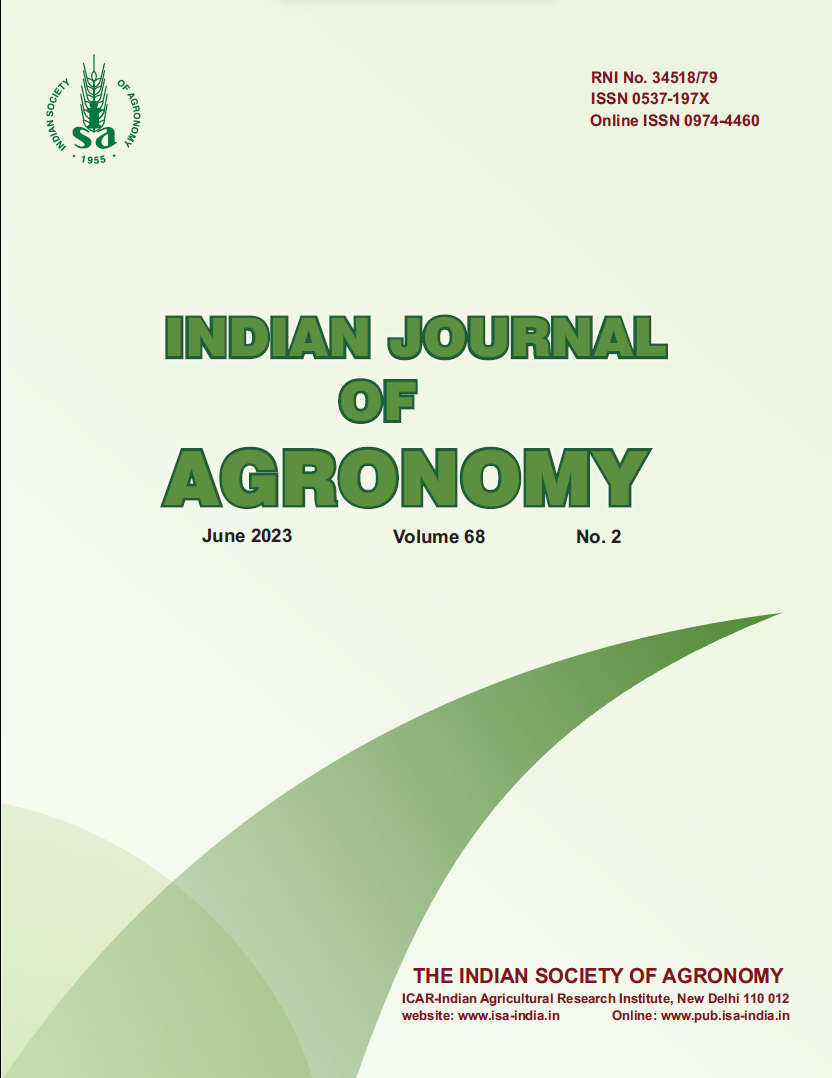Growth indices, photosynthetic parameters and productivity of barley (Hordeum vulgare) as influenced by sowing dates and cutting management
DOI:
https://doi.org/10.59797/ija.v68i2.349Keywords:
Grain yield, Growth indices, Stomatal conductance, Transpiration rateAbstract
A field experiment was conducted during the winter (rabi) seasons of 2015–16 and 2016–17 at the Punjab Agricultural University, Ludhiana, to study the effect of staggered sowing on growth indices, photosynthetic parameters and productivity of barley (Hordeum vulgare L.) in relation to different cutting management. The experiment was laid out in a split-plot design with 3 sowing dates, viz. 15 October, 30 October and 15 November in main plots and 5 cutting management, viz. un-cut (control), cut at 50 days after sowing (DAS), cut at 60 DAS, cut at 50 DAS + additional 15 kg N/ha after cut (N15) and cut at 60 DAS + additional 15 kg N/ha after cut (N15)] in subplots, replicated 4 times. The results indicated that, the crop sown on 15 October registered the highest values of absolute growth rate (AGR) and crop growth rate (CGR) up to 120 days of crop-growth. Thereafter, crop sown on 15 November showed higher AGR and CGR values than that sown on 15 October and 30 October. Relative growth rate (RGR) was the highest in the crop sown on 15 October up to 30 days; 30 October up to 120 days and 15 November thereafter. Fodder cut at 50 DAS and cut at 50 DAS + N15 treatments resulted in the negative values of AGR, CGR and RGR during 30–60 DAS. Transpiration rate and stomatal conductance decreased significantly and progressively with each delay in sowing. Uncut crop recorded the highest transpiration rate (0.53 m mol/m2 /sec), whereas the crop cut at 60 DAS resulted in the lowest transpiration rate (0.26 m mol/m2 /sec). Crop sown on 15 October resulted in 11.9 and 47.9% more grain yield and 18.3 and 25.2% more fodder yield than that sown on 30 October and 15 November, respectively. Control and cutting for fodder at 50 DAS gave similar grain yields, but were significantly higher than the other cutting-management treatments.
References
Acreche, M.M. and Slafer, G.A. 2011. Lodging yield penalties as affected by breeding in mediterranean wheats. Field Crops Research 122: 40–48.
Berry, P.M. and Spink, J. 2012. Predicting yield losses caused by lodging in wheat. Field Crops Research 137: 19–23.
Bhilare, R.L. and Joshi, Y.P. 2007. Productivity and quality of oats (Avena sativa L.) in relation to cutting management and nitrogen level. Indian Journal of Agronomy 22: 247–250.
Dhillon, B.S., Sharma, P.K. and Sardana, V. 2018. Influence of foliar application of boron and TIBA on photosynthetic parameters vis-a-vis productivity of sunflower (Helianthus annuus L.) under variable sowing dates. Journal of Agrometeorology 20(1): 16–21.
Dhillon, B.S. and Ram, H. 2020. Agroclimatic indices and yield of barley (Hordeum vulgare) under different cutting management and sowing dates. Indian Journal of Agronomy 65(2): 25–29.
Radford, P.J. 1967. Growth analysis formulae–their use and abuse. Crop Science 7: 171–175.
Rashid, A., Khan, R.U., Marwal, S.K. and Ali, Z. 2010. Response of barley to sowing date and fertilizer application under rainfed condition. World Journal of Agricultural Sciences 6: 480–485.
Singh, D., Singh, D.R., Nepalia, V. and Kumari, A. 2012. Performance of dual purpose barley (Hordeum vulgare L.) varieties for green fodder and subsequent productivity under varying seed rate and fertility management. Forage Research 38: 133–137.






